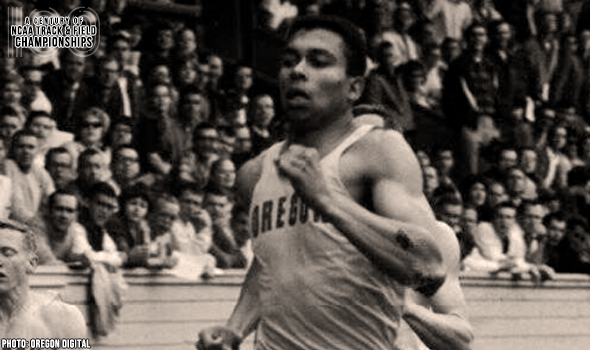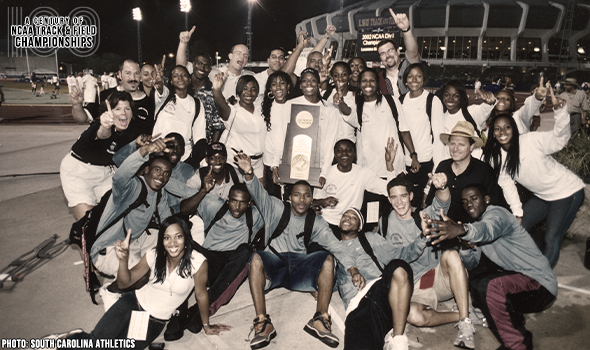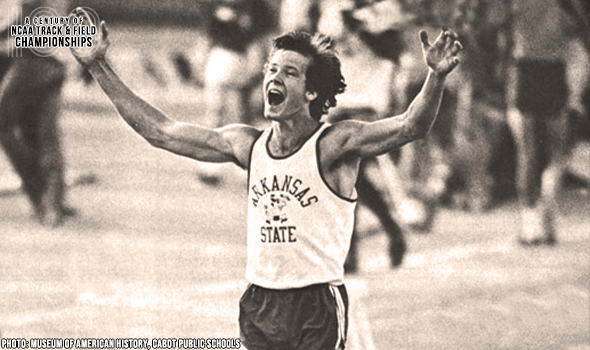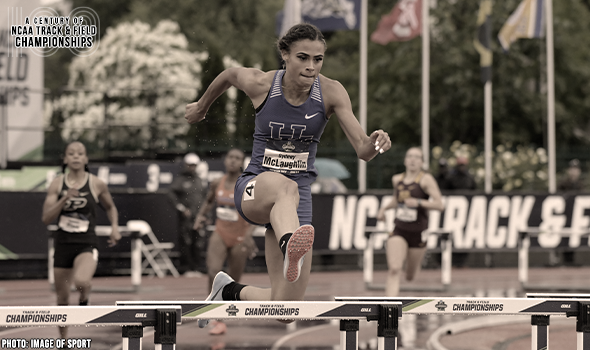
Oregon’s Jerome Sprinted To NCAA Glory
If ever a meet could have used photo-finish timing, it was the 1964 NCAA Outdoor Track & Field Championships.
The 5000 and 400 were both ruled deadlocks, but those were with merely two runners inseparable.
The 100-meter final saw three sprinters crossing the line at almost the same instant: Harry Jerome of Oregon, Edwin Roberts of North Carolina Central and Trenton Jackson of Illinois.
It took almost an hour to sort the finish, but when they did, Jerome was ruled the victor in 10.1. Roberts (second) and Jackson (third) were also credited with that same mark as well.
“Honestly, that’s one I’d hate to judge on,” Jerome said about the finish to Dick Leutzinger of the Eugene Register-Guard. “Usually I know when I win or lose. I’d hate to say on that one.”
While the 10.1 was a meet and collegiate record, it wasn’t a PR for Jerome. He still owned a share of the world record of 10.0 that he set in the summer after his freshman season back in 1960.
Jerome was a Canadian prodigy who came from great lineage. As a high school standout in North Vancouver, British Columbia, he broke a 31-year-old national record in the 220 yards. And many knew his grandfather, John Armstrong Howard, who was the first Black athlete to represent Canada in the Olympic Games.
The fact that Jerome was even running in 1964 – near his best, let alone at all – was a comeback story for the ages. Jerome tore his quadriceps tendon in the fall of 1962 at the British Commonwealth Games and the seriousness of the injury led many to believe that he would never run again. He didn’t believe that and a little over a year later, he opened the 1964 season by equaling the world indoor best in the 60-yard dash with his time of 6.0.
Then at the 1964 NCAA Championships, Jerome doubled back in the 200, taking third to lead Oregon to its second team title in three years – both at Hayward Field. The Ducks won their first national title in 1962 when Jerome won the 220 yards and was runner-up in the 100.
Not long after that, Jerome went to the Tokyo Olympic Games, where he earned his lone Olympic medal – a bronze in the 100.
Jerome died in 1982 of a brain aneurysm at age 42. In 1984, the Labatts Classic held in Burnaby was renamed the Harry Jerome Classic and in 1988 a statue of him was erected in Vancouver’s Stanley Park.
The NCAA and collegiate track & field will mark a momentous milestone in the spring of 2021 -- the 100th anniversary of the NCAA Championships and with that, the NCAA Track & Field Championships. In June 1921, the University of Chicago hosted the first track & field championships in NCAA history.
This point can’t be emphasized enough: Not only was the event the first for NCAA track & field, but the first championships for any sport under the sponsorship of the NCAA.
To celebrate, over each of the next 365 days, the U.S. Track & Field and Cross Country Coaches Association (USTFCCCA) will celebrate moments, student-athletes, and coaches that have made a century’s worth of championships special. From humble beginnings to important historical milestones to the modern-day, collegiate track & field has evolved with the American society.
The 2021 edition of the NCAA Division I Outdoor Track & Field Championships begin with preliminary round action on May 27-29 in Jacksonville, Fla., and College Station, Texas. The championships final site and culmination of the celebration is slated for June 9-12, 2021 at the newly rebuilt Hayward Field in Eugene, Ore.

Event Dominance Propelled South Carolina’s Run
South Carolina rose to prominence in the late 1990s to early 2000s thanks to a trio of extremely talented sprinters.

Calhoun High Hurdled Into The Record Book
Lee Calhoun of North Carolina Central set meet records in back-to-back years at the NCAA Outdoor Track & Field Championships!

Howl Yes! Bell Vaulted To Greatness
Earl Bell won three consecutive pole vault titles at the NCAA Division I Outdoor Track & Field Championships between 1975 and 1977,

McLaughlin Had No Hurdling Competition
In 2018, Sydney McLaughlin set a 400H collegiate record in May and then posted the largest margin of victory in NCAA DI meet history one month later.

Oregon’s Jerome Sprinted To NCAA Glory
Harry Jerome won two national titles at the NCAA Division I Outdoor Track & Field Championships, highlighted by a meet record in the 100 meters in 1964.

Levins Kicked Past Competition In 5K/10K
Cam Levins swept the 5K & 10K at the 2012 NCAA Division I Outdoor Track & Field Championships and won The Bowerman that same year.

Russell Dominated The 100H At NCAAs
Gillian Russell won three career 100H titles at the NCAA Division I Outdoor Track & Field Championships, doing so between 1993 and 1995.

Fosbury Flopped To High Jump Glory
Dick Fosbury, creator of the “Fosbury Flop,” won back-to-back high jump titles at the NCAA Outdoor Championships in 1968 and 1969 with meet records in both years.

Fleshman Starred In The 5000 Meters
Lauren Fleshman posted three victories in the 5000 meters at the NCAA Division I Outdoor Track & Field Championships in her career.

X-Man Reigned At 2006 NCAA Meet
Xavier Carter won four national titles at the 2006 NCAA Division I Outdoor Track & Field Championships, completing the only 100-400 sweep and helping the title-winning 4×100 and 4×400 relay teams.

